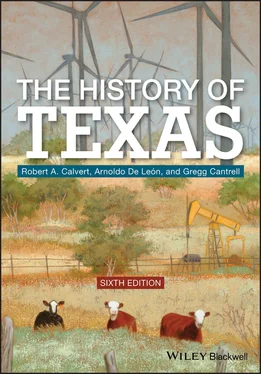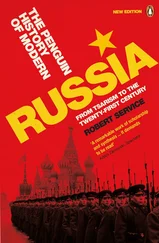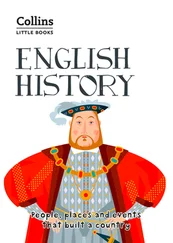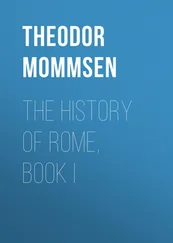Throughout Texas, the settlers continued to have their hands full with fighting the Apaches and Comanches. Gálvez thus pursued strong measures, in accordance with the New Presidio Regulations of 1772. Now assuming the powerful post of minister‐general of the Indies for Spain, Gálvez created in 1776 the Provincias Internas (the Internal Provinces), an administrative entity that comprised the present‐day north Mexican states as well as Texas, New Mexico, and California. The commandant‐general who headed this unit oversaw its military and civil administration. He answered to the king, and the governor of Texas reported to him.
Teodoro de Croix, an experienced military man in Europe and a veteran administrator in New Spain, was designated as the first commandant‐general of the Provincias Internas. He received instructions to give priority to Indian pacification. Carefully considering which tribes posed the principal threats, which alliances with which tribes would prove most effective, and what troop strength would be needed in the overall campaign, Croix concurred with Rubí that the Apaches were the main enemies and that collusion with the Comanches and other Norteño bands would best serve Spain’s purposes. But just as Croix was about to implement his offensive initiative in 1779, higher authorities recommended a new plan to contend with the Apache foes. Spain was, at the time, readying for renewed warfare in Europe and found it difficult to allocate precious resources for frontier campaigns. Croix was thus forced to forego his planned military drive against the Apaches and instead offer them small commissions and inexpensive presents in an effort to conciliate them, a strategy that hardly induced the Indians to cease their raids.
Texas Toward the End of the Spanish Era
Toward the late eighteenth century, the Crown began the secularization of the Texas missions. Secularization involved converting the missions from financial dependency on the government into parishioner‐supported institutions; the process assumed that the Indian converts had been transformed into productive citizens who could now function adequately as Spanish subjects. Although a couple of missions remained under the care of the friars toward the end of the Spanish period, the process of secularization proceeded, not culminating until the 1820s.
Several factors contributed to the desertion of the missions. Certainly, the last years of the eighteenth century had sorely tried Spanish tenacity. Carlos III was succeeded by a son lacking in wisdom, and political affairs on the European continent, starting with the French Revolution of 1789, soon engulfed Spain in shifting alliances with France and England. War with both Great Powers distracted attention from Spain’s commitment in the New World and diverted monies from New Spain back to the mother country.
Working alongside these developments were newer philosophical trends that questioned the program of missionization. Since the sixteenth century, Christianization had posited the equality of Indians with the rest of humankind. On that premise, Spain had sought to convert indigenous New World populations. The antichurch sentiment buoyed by the Enlightenment, however, wrought bad times for the missionaries. By the late eighteenth century, the Franciscans and the other regular clergy found themselves facing new demands for the secularization of missions. Despite protests from the friars, the intellectual currents of the late eighteenth century undermined efforts to continue missionary work in the name of the state.
Even at the local level, several factors worked against missionary activity in Texas. First, the economic stability of the province depended on a steady, marketable commodity, and livestock seemed to fit the bill closely. As their numbers grew, the pobladores began to covet the mission cattle, and government officials simultaneously saw the potential for increased tax revenue in transforming mission lands into private property. Second, the neophytes played a part in the breakdown of the religious institutions. From the beginning, the mission concept did not make for a happy arrangement between Europeans and Native Americans. Priests and presidial soldiers lorded over literally hundreds of charges, disciplining them with intimidation and cruelty. Confinement to the compound increased the chances of falling victim to everyday illnesses, as the pileup of rubbish and the accumulation of human waste served to breed germs responsible for diseases such as influenza. Mission life for the Indians further meant dehumanization and the abandonment of traditional lifeways and religious beliefs, not to mention their shameless exploitation at the hands of ranchers and presidial officials. Assimilation offered little hope, as it never entailed full acceptance into Spanish society. Some mission Indians rebelled by resisting the work expected from them by the missionaries, responding as other forced laborers have by feigning illness, turning to gambling or abusing alcohol, sabotaging work implements, intentionally showing up late for work, destroying sacred articles, and deriding the priesthood. Others only pretended to comply with Christian teachings, all the while putting on a front and retaining their loyalty to time‐honored customs and old religious precepts. Escape seemed the best alternative to their discontent, and it became the most visible sign of resistance. By the late eighteenth century, few potential Indian converts remained. As the program of secularization ended, the friars, despite all their work and numerous accomplishments for the Church and the Crown, could claim to have Christianized or Hispanicized only a small fraction of the total Native American population in Texas.
As for the indios bárbaros, they gave the settlers little respite. The presidial soldiers, upon whose shoulders lay the responsibility of maintaining the peace, never devised truly effective measures to ward off the Texas Indians. In many ways, their inability to carry out their purpose emanated from the design of the presidio system itself. Troops in command of large forts were not effective against such highly mobile enemies as the mounted Comanches and Wichitas, who attacked farmers in the fields, struck civilian settlements, raided ranches for horses (which they exchanged for guns available from westering US citizens), and harassed the neophytes who took refuge among the Spaniards. Moreover, many presidial installations were in constant need of repair, and their commanding officers often lacked good administrative skills. Militarily, the posts were understaffed, underequipped (with weapons not upgraded regularly), and often outfitted with horses unfit for service. Shortages of food and proper uniforms and the meager salaries awarded soldiers became perennial problems. Amid such conditions, morale among presidial personnel understandably remained low.
Finally, in the 1780s, the Crown returned to its earlier policy of trying to appease the Apaches by giving them gifts and rewards, also applying this to the Comanches and the other Norteños. Actually a tactic to divide and rule by playing one tribal band against another, this official bribery aimed to reduce the Indian forces, create animosity among them, and waylay intertribal alliances. For a time it worked, as a relative peace, albeit one punctuated by destructive clashes, ensued for roughly the next three decades.
The Comanches, in particular, ruthlessly attacked the settlements into the early decades of the nineteenth century. They did so determined to preserve the viability of their extensive trade system. Now, as Americans pushed westward from the Louisiana Territory, the Comanches could barter stolen livestock from Texas for dependable goods manufactured in the United States. Through this trade with the Americans, the Comanches came to see them as their allies, the Spanish as their enemies. Through their gift giving and other considerate gestures, the American frontier traders and merchants won acceptance into the Comanche cultural kinship world, one that associated charitable acts with friendship. Whereas Americans, as expressions of kinship commitment to foster trade, willingly gave the Comanches functional weapons and various articles deemed by Indian leaders as status worthy, the Spaniards generally rejected any such considerations, maintaining their policy of not trading firearms to Indians. Thus, the Comanche enmity toward the Spanish only grew, and the Indians continued their vicious assaults upon settlements in the Texas colony.
Читать дальше










